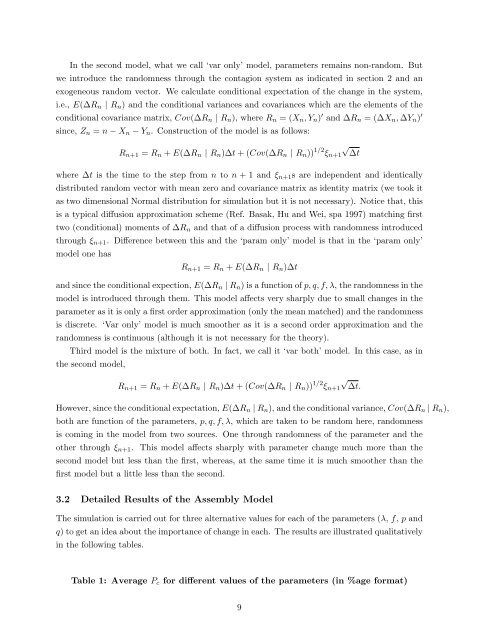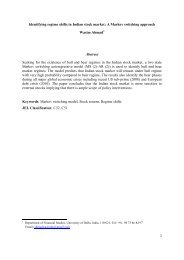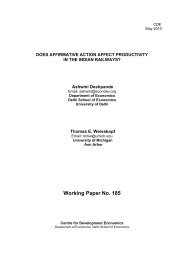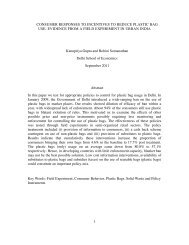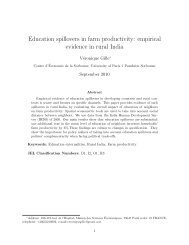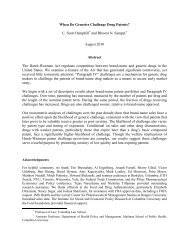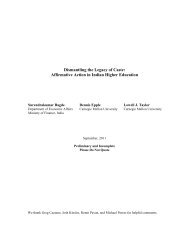Stochastic Dynamic Models for Political Regime Change and ...
Stochastic Dynamic Models for Political Regime Change and ...
Stochastic Dynamic Models for Political Regime Change and ...
You also want an ePaper? Increase the reach of your titles
YUMPU automatically turns print PDFs into web optimized ePapers that Google loves.
In the second model, what we call ‘var only’ model, parameters remains non-r<strong>and</strong>om. But<br />
we introduce the r<strong>and</strong>omness through the contagion system as indicated in section 2 <strong>and</strong> an<br />
exogeneous r<strong>and</strong>om vector. We calculate conditional expectation of the change in the system,<br />
i.e., E(∆R n | R n ) <strong>and</strong> the conditional variances <strong>and</strong> covariances which are the elements of the<br />
conditional covariance matrix, Cov(∆R n | R n ), where R n = (X n , Y n ) ′ <strong>and</strong> ∆R n = (∆X n , ∆Y n ) ′<br />
since, Z n = n − X n − Y n . Construction of the model is as follows:<br />
√<br />
R n+1 = R n + E(∆R n | R n )∆t + (Cov(∆R n | R n )) 1/2 ξ n+1 ∆t<br />
where ∆t is the time to the step from n to n + 1 <strong>and</strong> ξ n+1 s are independent <strong>and</strong> identically<br />
distributed r<strong>and</strong>om vector with mean zero <strong>and</strong> covariance matrix as identity matrix (we took it<br />
as two dimensional Normal distribution <strong>for</strong> simulation but it is not necessary). Notice that, this<br />
is a typical diffusion approximation scheme (Ref. Basak, Hu <strong>and</strong> Wei, spa 1997) matching first<br />
two (conditional) moments of ∆R n <strong>and</strong> that of a diffusion process with r<strong>and</strong>omness introduced<br />
through ξ n+1 . Difference between this <strong>and</strong> the ‘param only’ model is that in the ‘param only’<br />
model one has<br />
R n+1 = R n + E(∆R n | R n )∆t<br />
<strong>and</strong> since the conditional expection, E(∆R n | R n ) is a function of p, q, f, λ, the r<strong>and</strong>omness in the<br />
model is introduced through them. This model affects very sharply due to small changes in the<br />
parameter as it is only a first order approximation (only the mean matched) <strong>and</strong> the r<strong>and</strong>omness<br />
is discrete. ‘Var only’ model is much smoother as it is a second order approximation <strong>and</strong> the<br />
r<strong>and</strong>omness is continuous (although it is not necessary <strong>for</strong> the theory).<br />
Third model is the mixture of both. In fact, we call it ‘var both’ model. In this case, as in<br />
the second model,<br />
√<br />
R n+1 = R n + E(∆R n | R n )∆t + (Cov(∆R n | R n )) 1/2 ξ n+1 ∆t.<br />
However, since the conditional expectation, E(∆R n | R n ), <strong>and</strong> the conditional variance, Cov(∆R n | R n ),<br />
both are function of the parameters, p, q, f, λ, which are taken to be r<strong>and</strong>om here, r<strong>and</strong>omness<br />
is coming in the model from two sources. One through r<strong>and</strong>omness of the parameter <strong>and</strong> the<br />
other through ξ n+1 . This model affects sharply with parameter change much more than the<br />
second model but less than the first, whereas, at the same time it is much smoother than the<br />
first model but a little less than the second.<br />
3.2 Detailed Results of the Assembly Model<br />
The simulation is carried out <strong>for</strong> three alternative values <strong>for</strong> each of the parameters (λ, f, p <strong>and</strong><br />
q) to get an idea about the importance of change in each. The results are illustrated qualitatively<br />
in the following tables.<br />
Table 1: Average P c <strong>for</strong> different values of the parameters (in %age <strong>for</strong>mat)<br />
9


